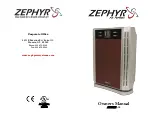
17 Maintenance and service
Installer and user reference guide
28
FCAHG71~140HVEB
Split system air conditioners
4P561449-1A – 2019.09
WARNING
The appliance shall be stored in a room without
continuously operating ignition sources (example: open
flames, an operating gas appliance or an operating electric
heater).
WARNING
▪ Do NOT pierce or burn refrigerant cycle parts.
▪ Do NOT use cleaning materials or means to accelerate
the defrosting process other than those recommended
by the manufacturer.
▪ Be aware that the refrigerant inside the system is
odourless.
WARNING
R410A is a non-combustible refrigerant, and R32 is a
mildly flammable refrigerant; they normally don’t leak. If the
refrigerant leaks in the room and comes into contact with
fire from a burner, a heater, or a cooker, this may result in
a fire (in case of R32), or the formation of a harmful gas.
Turn off any combustible heating devices, ventilate the
room, and contact the dealer from where you purchased
the unit.
Do not use the unit until a service person confirms that the
part from which the refrigerant leaked has been repaired.
17.6
After-sales service and warranty
17.6.1
Warranty period
▪ This product includes a warranty card that was filled in by the
dealer at the time of installation. The completed card has to be
checked by the customer and stored carefully.
▪ If repairs to the product are necessary within the warranty period,
contact your dealer and keep the warranty card at hand.
17.6.2
Recommended maintenance and
inspection
Since dust collects when using the unit for several years,
performance of the unit will deteriorate to some extent. As taking
apart and cleaning interiors of units requires technical expertise and
in order to ensure the best possible maintenance of your units, we
recommend to enter into a maintenance and inspection contract on
top of normal maintenance activities. Our network of dealers has
access to a permanent stock of essential components in order to
keep your unit in operation as long as possible. Contact your dealer
for more information.
When asking your dealer for an intervention, always state:
▪ The complete model name of the unit.
▪ The manufacturing number (stated on the nameplate of the unit).
▪ The installation date.
▪ The symptoms or malfunction, and details of the defect.
WARNING
▪ Do NOT modify, disassemble, remove, reinstall or
repair the unit yourself as incorrect dismantling or
installation may cause an electric shock or fire. Contact
your dealer.
▪ In case of accidental refrigerant leaks, make sure there
are no naked flames. The refrigerant itself is entirely
safe and non-toxic. R410A is a non-combustible
refrigerant, and R32 is a mildly flammable refrigerant,
but they will generate a toxic gas when they
accidentally leak into a room where combustible air
from fan heaters, gas cookers, etc. is present. Always
have qualified service personnel confirm that the point
of leakage has been repaired or corrected before
resuming operation.
17.6.3
Recommended maintenance and
inspection cycles
Be aware that the mentioned maintenance and replacement cycles
do not relate to the warranty period of the components.
Component
Inspection
cycle
Maintenance cycle
(replacements and/or
repairs)
Electric motor
1 year
20,000 hours
PCB
25,000 hours
Heat exchanger
5 years
Sensor (thermistor, etc.)
5 years
User interface and switches
25,000 hours
Drain pan
8 years
Expansion valve
20,000 hours
Solenoid valve
20,000 hours
The table assumes the following conditions of use:
▪ Normal use without frequent starting and stopping of the unit.
Depending on the model, we recommend not starting and
stopping the machine more than 6 times/hour.
▪ Operation of the unit is assumed to be 10 hours/day and
2,500 hours/year.
NOTICE
▪ The table indicates main components. Refer to your
maintenance and inspection contract for more details.
▪ The table indicates recommended intervals of
maintenance cycles. However, in order to keep the unit
operational as long as possible, maintenance work may
be required sooner. Recommended intervals can be
used for appropriate maintenance design in terms of
budgeting
maintenance
and
inspection
fees.
Depending on the content of the maintenance and
inspection contract, inspection and maintenance cycles
may in reality be shorter than listed.
17.6.4
Shortened maintenance and replacement
cycles
Shortening of "maintenance cycle" and "replacement cycle" needs to
be considered in following situations:
The unit is used in locations where:
▪ Heat and humidity fluctuate out of the ordinary.
▪ Power fluctuation is high (voltage, frequency, wave distortion, etc.)
(the unit cannot be used if power fluctuation is outside the
allowable range).
▪ Bumps and vibrations are frequent.





































